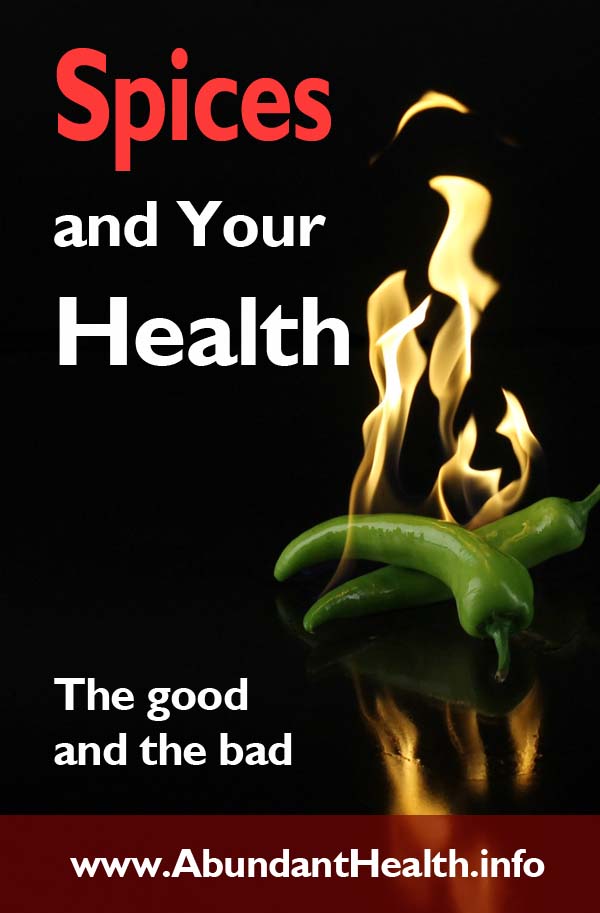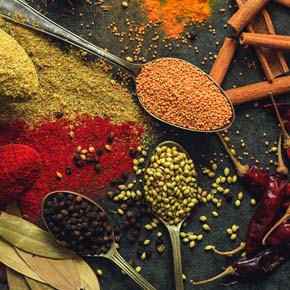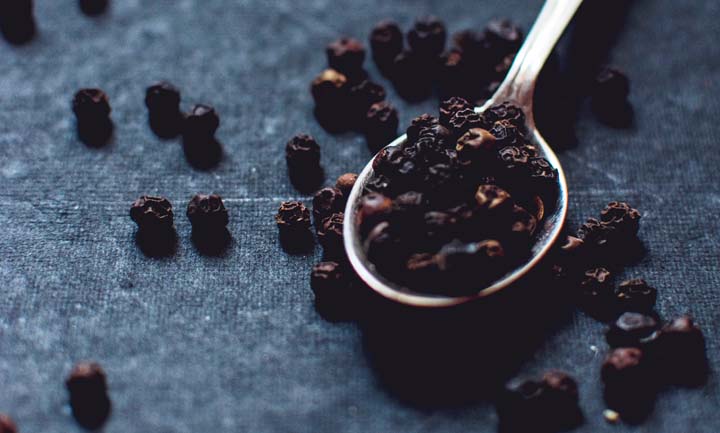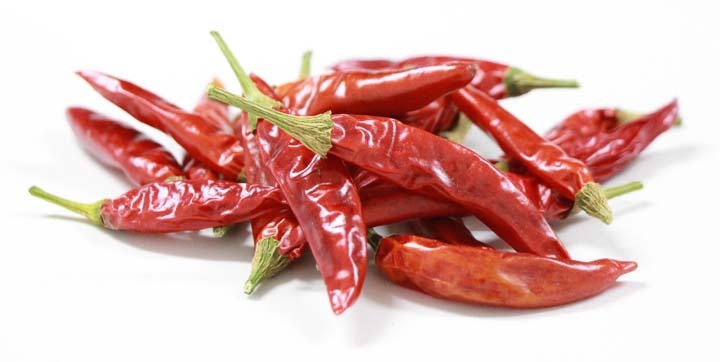Does the enticing smell of freshly baked cinnamon rolls, gingerbread, spice cake, or fruitcake awaken aromatic memories of holidays and cozy kitchens? Perhaps the punch-packed savory East Indian foods or zesty Mexican dishes are among your favorites. As implied by the old ditty,” sugar and spice and everything nice…”, spices have long been considered among the culinary delectables of the world.

Many of these pungent or aromatic plant food substances are used to flavor a great variety of foods from sweet to savory. Although culinarily popular, and at times also touted for medicinal value, a number of commonly used spices are actually deleterious to our health. Let’s explore the available information; but, before doing so, we will briefly review some pertinent physiology.
Gastric Mucosa 101
Our stomachs are regularly exposed to hydrochloric acid (HC1), a very strong substance released to facilitate proper digestion. The healthy stomach is protected from potent HCl and other powerful digestive enzymes by mucus-producing cells in its lining, called the mucosal barrier. The mucus produced by this integral barrier serves both to neutralize HCl and shield the stomach wall from irritation, erosion, and ulceration.
Research reveals a recipe for trouble
In research done while they were at Loma Linda University, neurophysiologist Dr. Bernell Baldwin and his wife,1)Baldwin, M. and B., Spices: recipe for trouble. 1 Health & Healing, 12(1):41. Dr. Marjorie Baldwin, wiretapped the major nerve on the surface of the stomach (vagus nerve), in dogs. This important nerve, among other duties, carries messages between the brain and the stomach. When the very delicate nerve endings of the stomach’s mucosa are irritated, this information is flashed instantly to the brain. When the Drs. Baldwin put a diluted salt solution (similar to body fluids) into the stomachs of anesthetized dogs, very little happened. However, when black pepper, cayenne pepper, mustard, or cinnamon was added to the salt solution, the stomach released bursts of electrical spikes—thus conveying irritation.
The Baldwins performed further studies, this time with rats. The rats were placed in small quarters. Physical restraint is a known stressor for rats, and the Baldwins wanted to evaluate the potential effect of stress coupled with a spicy diet—lifestyle factors not uncommon in society today. The results further implicated the tested spices as clearly harmful. Those rodents receiving spiced chow showed significant damage to the gastric mucosal barrier. From the greatest to the least effect, black pepper, cinnamon, cloves, and mustard were all shown to be harmful. Note that although mustard appears less damaging, its harmful effects were found to increase with continued use. The irritation it produced initially prompted an increased production of protective mucus. But with repeated usage, the mucus-producing mechanism became worn out and ulcers began to appear.
Effect of Certain Spices on the Stomachs of Stressed Rats
Area of mucosal damage (sq mm)
Control Diet (CD): 1.2
CD + mustard: 1.6
CD + cloves: 4.8
CD + cinnamon: 5.7
CD + black pepper: 7.1

Cloves, allspice, and cinnamon produce a similar effect. These spices contain eugenol, a phenol that also initially prompts increased mucus production but with continued intake exhausts this response. Again, increased susceptibility to ulcer formation results. Indeed, studies have demonstrated that eugenol emulsion applied directly to the gastric mucosa causes gastritis, inflammation, and compromise of the gastric mucosal barrier. Ouch! Those cinnamon rolls are beginning to sound a bit painful!
But the spices did not affect only the stomach. Black pepper, cloves, and cinnamon also produced significant deleterious effects on the electrical activity of the brain and heart. Blood pressure increases were frequently observed. And the rodents looked worse! But what really surprised the Drs. Baldwin was the rats’ poor dispositions. Those fed the spicy rat chow were much more irritable than the controls—fearful, feisty, and ready to bite. Hmmm… might make us think twice about what we eat! Irritating foods can make irritable people!
Let’s look a bit closer at some of these spices individually.
Black Pepper

Black pepper contains piperidine, a substance that causes the increased release of a hormone that stimulates the stomach to secrete more hydrochloric acid. Piperidine, also found in tobacco smoke, is a strong irritant to the skin and mucous T membranes. its potent nicotine-like actions on the peripheral and central nervous system produce synaptic stimulation followed by depression. When directly administered into the stomach, red or black pepper is associated with a significant increase in gastric acid and pepsin secretion, mucosal exfoliation and potassium loss-all of which may be undesirable and contribute to gastritis. Another high stress/high spice diet study by the Baldwins focused specifically on black peppers effects. Their findings also demonstrated its harmful effects on the stomach. The rats fed black pepper in their chow showed more than double the amount of stomach lesions with twice the area of damage to the mucosa.2)Baldwin, M. and B. Spices: recipe for trouble, in Nutrition for the Nineties, W.J. Craig, Golden Harvest Bks, 1999, pp. 245-6.
Cayenne pepper

Hot and spicy cayenne, also known as red or chili pepper, is indigenous to Mexico and Central America. Many herbalists recommend it for its purported medicinal benefits; some studies do show that when taken internally, it may help to burn fat as well as reduce blood cholesterol, triglyceride levels, and platelet aggregation. However, the evidence is conflicting as to whether the capsaicin in cayenne acts as a cancer-inducing or as a preventive agent, and whether it protects the stomach from ulcer formation or actually damages the gastric mucosal barrier. The jury does still seem to be out on this spice, but let’s consider what is known.
Dangers of internal use
Consumption of chili pepper increases gastric acid secretion and may aggravate duodenal ulcers.3)Craig, W.J., Herbs for Your Health. Golden Harvest Books, 2005, p. 16. Capsaicin has been known to cause gastric ulcers, while the consumption of red pepper can aggravate symptoms of duodenal ulcers. Furthermore, consumption of chili pepper may increase the risk of stomach cancer. In a randomly selected study done in Mexico, chili pepper consumers had a 5.49 percent increased risk for gastric cancer compared with non-consumers. Among consumers, there was a highly significant positive association between self-rated increased levels of consumption (low, medium, and high) and increased risk. The odds-ratio for increased gastric cancer risk for high-level consumers as compared with non-consumers was 17:11.4)Lopez-Carnillo, L., et al., Chili Pepper Consumption and Gastric Cancer in Mexico: A Case-Control Study. Am J Epidemiology, l39(3):263—27l, 1994.
Topical applications
When applied externally to the skin, cayenne works as an analgesic. Capsicum depletes the nerve endings of substance P, a chemical involved in the transmission of pain signals and inflammation of the nerves, hence desensitizing the nerve fibers. According to nutritionist and herbalist Winston Craig, PhD., topical applications of capsaicin have been shown to be an effective treatment for decreasing the tenderness and pain of osteoarthritis as well as relieving the pain of muscle tension, shingles, diabetic neuropathy, and postmastectomy surgery.5)Craig, Herbs for Your Health, pp. 16-19.
However, longer-term use of capsicum ointment damages the nerve fibers in the epidermis of the skin. Within six weeks after usage cessation, this damage is repaired. Craig recommends that capsicum cream be applied no more than three or four times per day for several days. It is best to allow at least two weeks before applying any other solutions to the same area. The herbalist Varro Tyler, PhD. suggests three to four applications a day for up to a month as a safe option. When applying capsicum cream, be sure to avoid putting it on open wounds, cuts, or near the eyes. Immediately wash with soap your hands or any other area where capsicum has been applied before exposing the same body area(s) to hot or cold applications because heat plus capsicum cream increases the risk of burns.
Nutmeg (and mace)

Did you know that the seeds of nutmeg are utilized for more than flavoring foods and drinks? Due to its mind—altering properties, this spice is not uncommonly also used as a drug. Producing frightening and unpleasant side effects, nutmeg abuse is responsible for numerous documented cases of poisoning and intoxication, at least one of which was fatal. This ought to wave a red flag for those tempted to embellish their holiday or special-occasion cookery with this aromatic but psychotropic spice! Nutmeg contains several compounds with structural similarities to that of substances involved in modulating the central nervous system – resulting in potentially adverse effects. Researchers believe that the body can convert some of the spice’s chemical components into amphetamine—like compounds.6)Angalli, B.C., et al, Toxicology of nutmeg abuse, J Clin Toxicol, 38(6):6781-8, 2000.
One teaspoon of ground nutmeg can cause hallucinations, nausea, vomiting, visual disturbances and/or circulatory collapse within one to six hours after consumption. Very large doses can be fatal.
The cholinergic pathways of the central nervous system play a prominent role in the learning and memory processes. Acetylcholinesterase is an enzyme that inactivates acetylcholine, one of the neurotransmitters involved in learning and memory. Nutmeg significantly decreases acetylcholinesterase activity. Although this might seem to help memory, it is at the expense of other faculties of the mind. In other words, by exaggerating cholinergic activity, nutmeg lessens self-control and increases stimulation of the lower passions.
The spice mace is derived from the outer portion of the nutmeg seed; it contains the same harmful properties as nutmeg, and is therefore also not recommendable for internal use.
Cinnamon

Beyond adding that unique and aromatic flavor to numerous favorite recipes, cinnamon is also considered by many herbalists to be useful medicinally. its primary purported beneficial properties can be summarized as the following:
Blood thinner: The cinnaldehyde in cinnamon appears to help prevent unwanted clumping of blood platelets.
Antimicrobial agent: Studies show that cinnamon has the ability to help stop the growth of both bacteria and fungi, including the commonly problematic yeast, candida.
Diabetic support: You may have heard about cinnamon’s purported boons for individuals with diabetes. Several small recent studies, but not all, suggest that it may improve insulin—response ability in those with type 2 diabetes. When 1 to 6 grams of cinnamon per day for 40 days was given to 60 Pakistani volunteers with type 2 diabetes, they experienced an 18 to 29 percent drop in blood sugar. Cholesterol and triglyceride levels were lowered as well.7)Khan, et al, Cinnamon improves glucose and lipids of people with type 2 diabetes. Diabetic Care, December 26, 3215-8, 2003.
In another small placebo—controlled study, the effect of cinnamon was evaluated on 60 people with type 2 diabetes. Thirty men and thirty women ranging in age from 44 to 58 years were divided into six groups. Groups 1, 2, and 3 were given 1, 3, or 6 grams of cinnamon daily, while groups 4, 5, and 6 received 1, 3 or 6 grams of the placebo. After 40 days, all three levels of cinnamon had reduced blood sugar levels by 18 to 29 percent, triglycerides by 23 to 30 percent, LDL cholesterol by 7 to 27 percent, and total cholesterol by 12 to 26 percent, while no significant changes were seen in those groups receiving the placebo.8)Anderson, R.A., Chromium and polyphenols from cinnamon promote insulin sensitivity. Proc Nutr Soc, 67(1):48-53, 2008.
In contrast, a randomized study from the Nutrition and Toxicology Research institute showed that 12 weeks of taking l.5 grams of cinnamon a day did not improve the blood sugar or blood lipids in patients with type 2 diabetes.9)Vanschoonbeek, K., et al, Cinnamon supplementation does not improve glycemic control in post-menopausal type 2 diabetic patients. J Nutr, 136(4):977-80, 2006. As late as 2006, the authors of this study concluded that, “More research on the proposed health benefits of cinnamon supplementation is warranted before health claims should be made.” Other researchers have reported likewise, thus larger, controlled, and double-blinded studies are needed, before ”jumping on the bandwagon.”
Hidden dangers in cinnamon
The potentially toxic compounds in cinnamon bark have been found to be primarily present in the fat-soluble fractions. Levels of these compounds are very low in the water-soluble cinnamon extracts, which are the ones containing the insulin-enhancing compounds. We might postulate that certain medicinal preparations of cinnamon could then be relatively safe to use, but a number of factors ought to put the judicious on hold. It would need to be ascertained whether the botanical processing of cinnamon for medicinal preparations would remove all or some of these toxic fat-soluble compounds. But the regular ground or stick cinnamon commonly used in food and beverages is certainly implicated; these forms of the spice definitely still contain the incriminated fat-soluble fractions.
Let’s look more closely at the harmful compounds found in cinnamon’s fat-soluble portions, namely that of methyl eugenol and estragole. Eugenol has been demonstrated to produce chromosomal aberrations and other adverse changes in DNA.10)Maralhas, A., et al, Genotoxicity and endore-duplication inducing activity of food flavouring eugenol. Mutagenesis, 21 (3):199-204, 2006. Estragole, a natural organic compound found in cinnamon and other plants, is used in perfumes and as a food additive for flavor. Studies appear to implicate it as being both carcinogenic and genotoxic.11)Smith, R.1.., Safety assessment of allylalkoxybenzene derivatives used as flavouring substances—methyl eugenol and estragole. Food Chem Toxicol,40(7):851-70, 2002. Using animal models, researchers have found that methyl eugenol adversely affects the liver, kidney, and stomach. The development of liver cancers, glandular stomach lesions, and malignant neuroendocrine tumors may result.12)Johnson, J.D., et al., Two-year toxicity and carcinogenicity study of methyl eugenol in F344/N rats and B6C3F(l) mice. JAgriC Food Chem, 48(8):3620-32, 2000. In addition, aldehydes from cinnamon-flavored chewing gum were found to be a contributing factor in inflammation of the mouth and gums, precancerous white spots on mouth tissues (leukoplakia), and cancer of the tongue.13)Miller, R.K., et al, Ora1Su1gMed Oral Pathol, 73(6):708-16, 1992.
Endo, H. and Rees, T.D., Compend Cont Educ Demt, 27(7):403-9, 2006.
Endo, H. and Rees, T.D., Cinnamon products as a possible etiologic factor in oralfacial granulomatosis. Med Oral Pathol Cir Bucal, (12(6):E440-4, 2007.
Chalandussia, E., et al, Oral Dis, 13(1):93-8, 2007.
Although the doses of methyl eugenol used in animal experiments are much greater than humans generally consume, “further studies are needed to define both the nature and implications of the dose-response curve in rats at low levels of exposure to methyl eugenol and estragole.” Furthermore, according to the Opinion of the Scientific Committee on Food on Methyleugenol, European Commission on Health and Consumer Protection, Directorate-General, September 26,2001, “…the existence of a threshold [for methyl eugenol] cannot be assumed and the Committee could not establish a safe exposure limit. Consequently, reductions in exposure and restrictions in use levels are indicated.”14)Smith, Safety assessment of allylalkoxy-benzene…. Food Chem Toxicol. Because many prevalent lifestyle factors such as alcohol, obesity, diabetes, street drugs, and prescribed medications damage the liver and the stomach, is it plausible that even smaller amounts of methyl eugenol and cinnamon could prove harmful to already taxed bodies? Is it possible that other phytochemicals in cinnamon might counteract methyl eugenol’s detrimental effects somewhat or altogether? These and other questions remain; thus it seems wise to wait until more conclusive research is done before cinnamon be recommended for medicinal use. Laying aside these unknowns, additional concerns with cinnamon exist. Cinnamaldehyde is an irritant that produces major electronic spikes in the hypothalamus. The hypothalamus, along with other members of the limbic system, regulates appetite, sexual passions and rage. Cinnamon, therefore, after stimulating receptors in the stomach, arouses the lower nature of man. Both the cinnamaldehye in cinnamon and eugenol in cloves disturb enzymes involved in the release of energy from ATP, the major energy-producing molecule in the body.”15)Usta, J. et al, A comparative study on the effect of cinnamon and clove extract and their main components on different types of ATPases. Human Exp Toxicol, 22(7):355—62, 2003.
It should also be noted that cinnamon oil is highly irritating to the skin and mucous membranes and should never be used undiluted. One of its oils not only inflames and corrodes the stomach lining, but also that of the upper intestines.”16)Baldwin, B. and M. Spices—recipe for trouble, in Nutrition for the Nineties, p. 246.
Because cinnamon is a spice with considerable documented adverse side effects, the medical staff advising this publication cannot recommend its use.
Summary on Spice Status
Spices, wisely administered, can serve useful and pleasant purposes. Capsaicin ointment can provide relief of diabetic neuropathy. Ginger and turmeric, if internally taken, provide a number of medicinal benefits, as well as a rich load of healthful phytochemicals.
Whether providing culinary, aromatic, cleansing, or medicinal benefit, the Creator surely had a good purpose in mind for each of the plants He made. It behooves us to carefully search out the safest ways to utilize these natural gifts, for as we’ve seen, improperly used, spice is not always so “nice!” What science has not already revealed regarding their actual properties may very well be more fully clarified in the future. But with confidence we can accept the Great Designers promise that, “The blessing of the Lord maketh rich, and He addeth no sorrow unto it.” (Proverbs 10:22) Whatever benefits God has provided for us, whether for culinary enjoyment, nutritional benefit, or medicinal use, will only help and not hurt when properly utilized. The blessings He offers are not mixed ones, even in the realm of health! And thankfully we can claim His help to renew us—right down to our taste buds! Flavors that we may have thought we could just not do without can be satisfactorily replaced with something better! We hope some or all of the following recipes will offer just that!
Recipes
The following recipes are just a few examples of non-irritating spice options.
Try experimenting yourself, too, and enjoy!
Curry Powder
Mix well in small bowl:
3 tbsp cumin
2 tsp coriander
1/4 tsp fenugreek
1/2 tsp salt
1/4 tsp cardamon
Bottle and label.
Chili seasoning
6 bay leaves
2 tsp basil
1/3 c parsley flakes
1 tbsp oregano
Transfer to a small mixing bowl and add:
1 1/2 tsp onion powder
1/2 tsp garlic powder
1/4 c paprika
5 tbsp cumin
Grind all. Store in an airtight container.
Various cinnamon alternatives
#1: ground coriander seed
#2: 1 part cardamom
3 parts coriander
Mix well, bottle, and label.
#3: 3 parts coriander seeds
1 part sweet anise seed
Grind together. Bottle and label.
#4: Ingredients such as lemon or orange extract or peel, butterscotch, vanilla, or maple do not replicate cinnamon’s taste but can add other pleasant flavors to recipes.
This article was published originally in the Journal of Health and Healing, a publication of Wildwood Lifestyle Center.
Elizabeth Hall has taught and researched health topics for more than 35 years at Wildwood Lifestyle Center and Hospital at Wildwood, GA.
References
| ↑1 | Baldwin, M. and B., Spices: recipe for trouble. 1 Health & Healing, 12(1):41. |
|---|---|
| ↑2 | Baldwin, M. and B. Spices: recipe for trouble, in Nutrition for the Nineties, W.J. Craig, Golden Harvest Bks, 1999, pp. 245-6. |
| ↑3 | Craig, W.J., Herbs for Your Health. Golden Harvest Books, 2005, p. 16. |
| ↑4 | Lopez-Carnillo, L., et al., Chili Pepper Consumption and Gastric Cancer in Mexico: A Case-Control Study. Am J Epidemiology, l39(3):263—27l, 1994. |
| ↑5 | Craig, Herbs for Your Health, pp. 16-19. |
| ↑6 | Angalli, B.C., et al, Toxicology of nutmeg abuse, J Clin Toxicol, 38(6):6781-8, 2000. |
| ↑7 | Khan, et al, Cinnamon improves glucose and lipids of people with type 2 diabetes. Diabetic Care, December 26, 3215-8, 2003. |
| ↑8 | Anderson, R.A., Chromium and polyphenols from cinnamon promote insulin sensitivity. Proc Nutr Soc, 67(1):48-53, 2008. |
| ↑9 | Vanschoonbeek, K., et al, Cinnamon supplementation does not improve glycemic control in post-menopausal type 2 diabetic patients. J Nutr, 136(4):977-80, 2006. |
| ↑10 | Maralhas, A., et al, Genotoxicity and endore-duplication inducing activity of food flavouring eugenol. Mutagenesis, 21 (3):199-204, 2006. |
| ↑11 | Smith, R.1.., Safety assessment of allylalkoxybenzene derivatives used as flavouring substances—methyl eugenol and estragole. Food Chem Toxicol,40(7):851-70, 2002. |
| ↑12 | Johnson, J.D., et al., Two-year toxicity and carcinogenicity study of methyl eugenol in F344/N rats and B6C3F(l) mice. JAgriC Food Chem, 48(8):3620-32, 2000. |
| ↑13 | Miller, R.K., et al, Ora1Su1gMed Oral Pathol, 73(6):708-16, 1992. Endo, H. and Rees, T.D., Compend Cont Educ Demt, 27(7):403-9, 2006. Endo, H. and Rees, T.D., Cinnamon products as a possible etiologic factor in oralfacial granulomatosis. Med Oral Pathol Cir Bucal, (12(6):E440-4, 2007. Chalandussia, E., et al, Oral Dis, 13(1):93-8, 2007. |
| ↑14 | Smith, Safety assessment of allylalkoxy-benzene…. Food Chem Toxicol. |
| ↑15 | Usta, J. et al, A comparative study on the effect of cinnamon and clove extract and their main components on different types of ATPases. Human Exp Toxicol, 22(7):355—62, 2003. |
| ↑16 | Baldwin, B. and M. Spices—recipe for trouble, in Nutrition for the Nineties, p. 246. |
This is very interesting thank for sharing. I need to reduce the intake of some spices. Loved it.
Thank you for this. I have to study it carefully
Blessings, a great reminder and a good read, I almost forgot why I didn’t consume these spices and had began the evil trend again. I have been revived, and by the grace of God I shall reform.